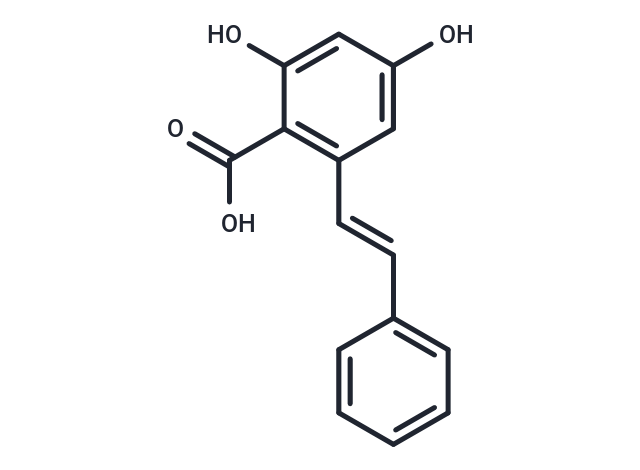Shopping Cart
Remove All Your shopping cart is currently empty
Your shopping cart is currently empty
Pinosylvic acid is a Pinosylvin derivative, Pinosylvin can play an antioxidant role by scavenging free radicals, inhibiting protein kinase C and other mechanisms, and has a variety of biological functions such as antifungal, antibacterial, anticancer, anti-inflammatory, antioxidant, neuroprotective, antiallergic and so on.Pinosylvic acid is a competitive inhibitor of lunularic acid decarboxylase.

| Pack Size | Price | USA Warehouse | Global Warehouse | Quantity |
|---|---|---|---|---|
| 1 mg | $195 | - | In Stock | |
| 5 mg | $483 | - | In Stock | |
| 10 mg | $692 | - | In Stock | |
| 25 mg | $1,080 | - | In Stock | |
| 50 mg | $1,490 | - | In Stock | |
| 100 mg | $1,970 | - | In Stock | |
| 200 mg | $2,690 | - | In Stock |
| Description | Pinosylvic acid is a Pinosylvin derivative, Pinosylvin can play an antioxidant role by scavenging free radicals, inhibiting protein kinase C and other mechanisms, and has a variety of biological functions such as antifungal, antibacterial, anticancer, anti-inflammatory, antioxidant, neuroprotective, antiallergic and so on.Pinosylvic acid is a competitive inhibitor of lunularic acid decarboxylase. |
| In vitro | Pinosylvic acid (10µM, 20µM, 50µM) was used to treat RAW264.7 macrophages, and after LPS-induced inflammation, various Methods including the Griess assay, quantitative PCR, Western blotting, and immunofluorescence were employed for detection. The Results showed that Pinosylvic acid (10-50µM) significantly inhibited LPS-induced NO production (P<0.001), reduced the mRNA and protein expression levels of IL-1β, IL-6, and TNF-α, and inhibited the nuclear translocation of NF-κBp65. These findings suggest that Pinosylvic acid exhibits significant anti-inflammatory activity in vitro by inhibiting the NF-κB signaling pathway [1]. |
| In vivo | In inflammation and cardiovascular disease in vivo experimental models in rats or mice, Pinosylvic acid (at doses of 10-50mg/kg) was administered via oral or intraperitoneal injection for a duration of 14-28 days. The Results showed that Pinosylvic acid significantly reduced MPO activity and levels of inflammatory markers such as TNF-α. In cardiovascular disease models, it effectively improved myocardial function and alleviated myocardial damage. Histological analysis revealed that Pinosylvic acid could reduce infiltration of inflammatory cells and tissue damage. The study confirmed that Pinosylvic acid exhibited significant anti-inflammatory effects in vivo, provided protective effects against cardiovascular diseases, and showed no apparent toxicity or side effects during the experiment, indicating good safety[2]. |
| Molecular Weight | 256.25 |
| Formula | C15H12O4 |
| Cas No. | 38232-09-6 |
| Smiles | C(=C/C1=CC=CC=C1)\C2=C(C(O)=O)C(O)=CC(O)=C2 |
| Relative Density. | no data available |
| Storage | store at low temperature | Powder: -20°C for 3 years | In solvent: -80°C for 1 year | Shipping with blue ice. |
| Size | Quantity | Unit Price | Amount | Operation |
|---|

Copyright © 2015-2025 TargetMol Chemicals Inc. All Rights Reserved.